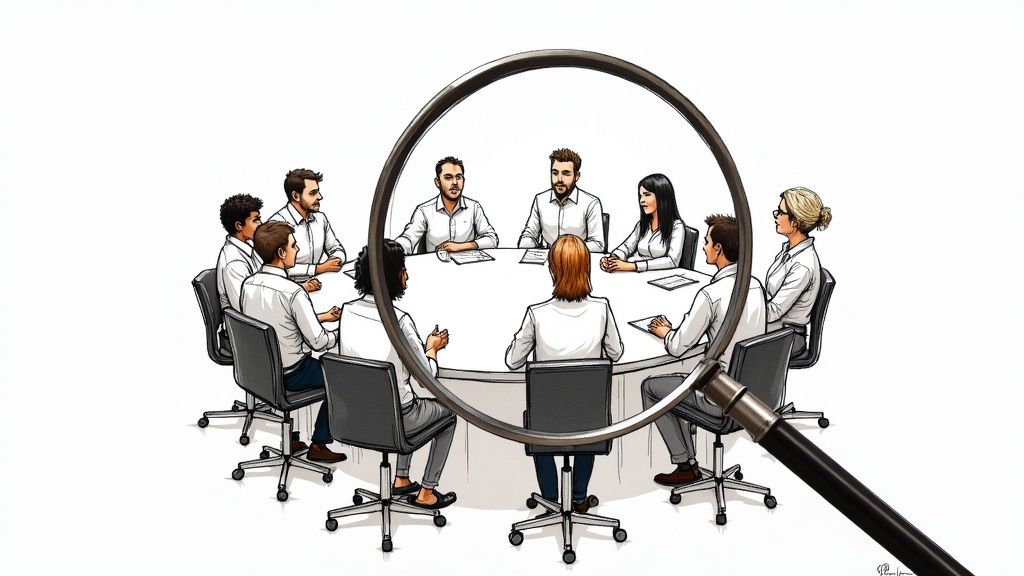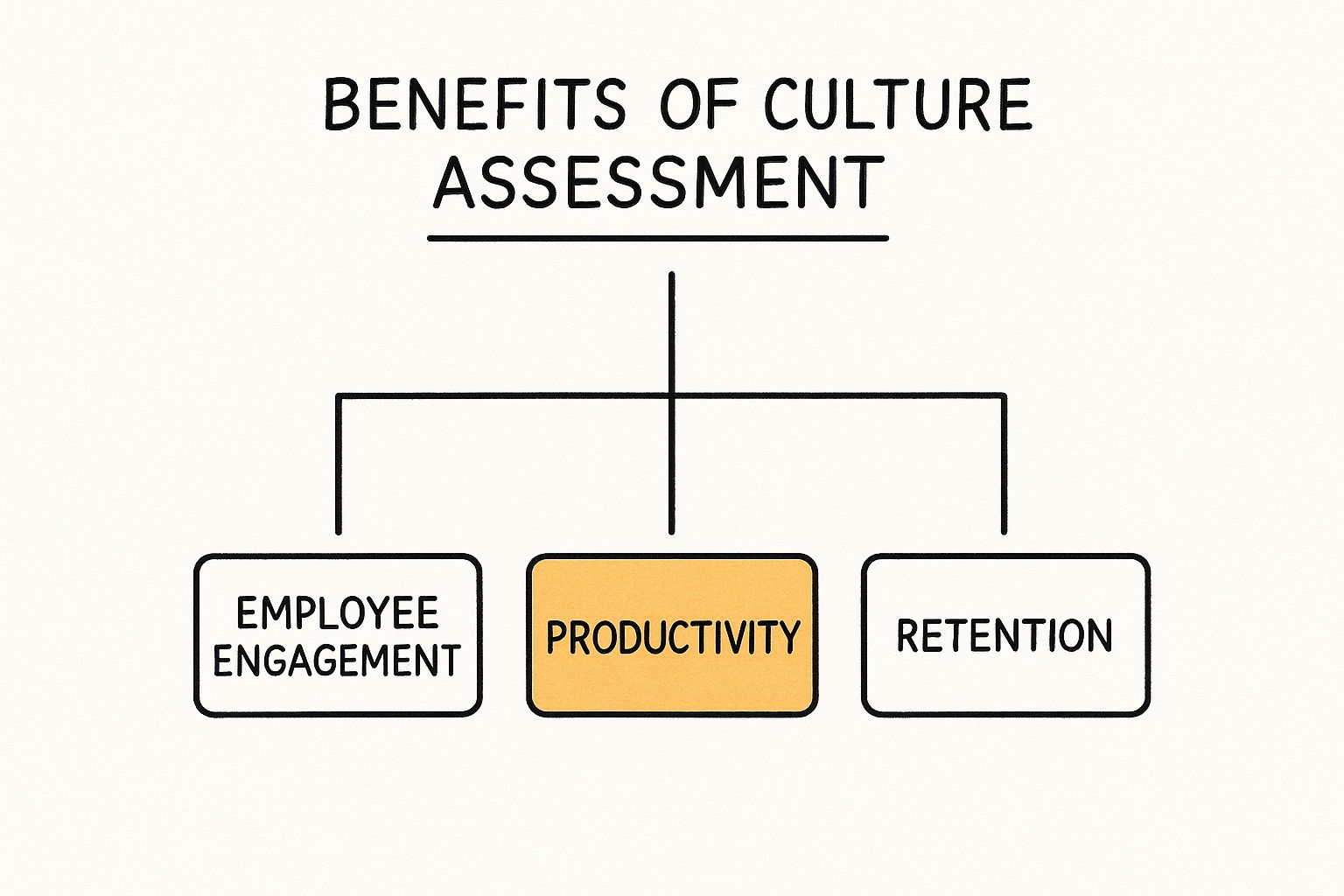A Guide to Modern Culture Assessment

A culture assessment is essentially a deep dive into your organization's unwritten rules—the shared values, beliefs, and behaviors that dictate how everything actually gets done. Think of it like a regular health check-up for your company. You can't fix what you don't measure, and culture is no different.
Why Culture Assessment Is Your Greatest Competitive Edge

Picture your company’s culture as its operating system. It's always running in the background, shaping every decision, interaction, and result. When that "OS" is efficient and aligned with your goals, your business hums along beautifully. But when it's buggy or outdated, you start seeing system crashes in the form of low productivity, poor engagement, and high turnover. A formal culture assessment is the diagnostic tool you need to understand and fine-tune this critical system.
This process takes you beyond just gut feelings or a few stories from the breakroom. It gives you a structured way to measure the collective habits and unspoken norms that truly define your workplace. By methodically evaluating your culture, you move from guessing what your employees are experiencing to knowing with confidence.
The Strategic Value of Measuring Culture
It's a huge mistake to treat a culture assessment as just another HR checklist item. Its real power comes from its role as a strategic business tool that can uncover both your hidden strengths and the vulnerabilities that could hold you back. A well-run assessment gives you the hard data needed to make smart decisions that impact the entire organization.
The insights you get are directly linked to the bottom line. For example, getting a clear picture of your cultural dynamics can help you:
- Boost Employee Engagement: Engaged employees are more productive and innovative. Evidence from Gallup shows that business units in the top quartile of engagement are 23% more profitable than those in the bottom quartile.
- Improve Talent Attraction: In a competitive job market, a strong, positive culture is a magnet for top talent. A 2019 Glassdoor survey found that 77% of adults would consider a company's culture before applying for a job there.
- Increase Retention Rates: When you can spot and fix cultural pain points before they become major issues, you stop the revolving door of talent. Research from Columbia University indicates that the likelihood of job turnover at an organization with a rich company culture is a mere 13.9%, compared to 48.4% in a poor company culture.
According to research from Great Place to Work, when employees feel genuinely recognized for their contributions, they are 2.6 times more likely to believe promotions are fair. This creates a more equitable and motivating environment, showing how a culture of recognition—something an assessment can pinpoint—directly shapes perceptions of fairness and career opportunities.
At the end of the day, a culture assessment gives you a clear roadmap for intentional change. It empowers leaders to stop being reactive to problems like burnout or high turnover and start proactively building an environment where people can thrive. In a world where your best people have plenty of options, a deliberately crafted culture isn't just a nice-to-have—it's your most sustainable competitive advantage.
The Hidden Costs of Neglecting Your Company Culture
Let's be blunt: ignoring your company culture isn't a passive choice. It's an active decision with real, and often severe, financial consequences. A toxic or undefined culture doesn't just feel bad; it quietly eats away at your resources, fueling the very problems that keep leaders up at night. Think of it as a silent tax on your operations, one that shows up everywhere from the balance sheet to your team's daily morale.
When communication is broken, psychological safety is a fantasy, and no one is aligned on what truly matters, you create the perfect storm for burnout and disengagement. This leads to a revolving door of talent. Your best people start heading for the exit, and the costs go far beyond simple recruitment fees.
The real financial damage comes from lost productivity, knowledge walking out the door, and the ripple effect on the morale of those who stay behind. A proactive culture assessment is your first real step to stop this financial bleed. It turns culture from a "soft" HR topic into an urgent business priority.
The Financial Drain of Disengagement and Turnover
A disengaged workforce is an expensive liability. It's that simple. When people feel disconnected from their work and the company's purpose, their productivity tanks, and their eyes start wandering to job boards. This isn't just a hunch; it's a measurable trend with startling financial baggage. The cost of replacing an employee isn't just their salary—it's the massive productivity gap you're left with while a new hire slowly gets up to speed.
Recent data from Gallup's State of the Global Workplace: 2023 Report paints a clear picture. The report found that low employee engagement costs the global economy an estimated $8.8 trillion, equivalent to 9% of global GDP. This widespread apathy is a primary driver of turnover, as disengaged employees are significantly more likely to look for new jobs. Gallup estimates that the cost of replacing an individual employee can range from one-half to two times the employee's annual salary. You can explore more shocking workplace culture stats to see the full impact.
This trend is exacerbated by high stress levels. The same Gallup report revealed that 44% of employees experienced a lot of stress the previous day, a figure that continues a trend of elevated stress that began during the pandemic.
This toxic cocktail of low engagement and high stress hits the bottom line hard through increased absenteeism and ballooning operational costs. According to Gallup, businesses with engaged employees see 81% less absenteeism and experience 64% fewer safety incidents compared to their disengaged counterparts.
Linking Cultural Health to Business KPIs
The shockwaves from a neglected culture travel far beyond HR metrics, directly hitting the critical business KPIs that every C-suite executive lives and breathes. A strong, positive culture isn't an expense; it's one of the best investments you can make, with measurable returns across the entire business.
Think about it: a culture that lacks psychological safety—where people are afraid to speak up or admit a mistake—is a place where innovation goes to die. Research from Google's Project Aristotle identified psychological safety as the single most important dynamic in high-performing teams. When new ideas are met with criticism or, even worse, indifference, creativity withers. This directly hobbles a company's ability to adapt, solve tough problems, and stay ahead of the competition.
Here are a few more ways a poor culture poisons your KPIs:
- Customer Satisfaction: Disengaged employees rarely deliver great customer service. Their lack of passion is contagious. Organizations in the top quartile for employee engagement achieve 10% higher customer loyalty and engagement ratings.
- Quality and Error Rates: In high-pressure, low-support environments, mistakes multiply. Burnout and a lack of focus lead to higher error rates. Companies with engaged workforces see 41% fewer quality defects.
- Employer Brand and Recruitment Costs: A toxic culture gets a reputation fast, especially on platforms like Glassdoor. This damages your employer brand, making it significantly harder and more expensive to attract top-tier talent.
Ultimately, a culture assessment gives you the diagnostic data to connect these dots. It shows exactly how "soft" issues like communication and trust are tied to "hard" numbers like revenue, profit, and customer retention. It makes an undeniable business case for managing your culture with intention.
Choosing the Right Culture Assessment Method
Trying to measure something as elusive as company culture can feel a bit like trying to bottle lightning. It’s powerful, it’s everywhere, but how do you actually get your hands on it? The secret to a successful culture assessment is picking the right tools for the job.
Think of yourself as a detective. You wouldn't solve a case with just one piece of evidence, right? You need to combine different approaches to see the full picture. For culture, this means blending two key methods: quantitative and qualitative. One tells you what's happening, and the other explains why. Using just one is like trying to watch a movie on mute—you’ll get some of the story, but you’ll miss all the crucial dialogue.
Quantitative Methods: What the Data Says
Quantitative methods are all about numbers. They give you the 30,000-foot view of your organization by collecting structured, measurable data. These tools are perfect for spotting broad trends, seeing how you stack up against industry benchmarks, and getting a statistical snapshot of your entire workforce.
The most popular quantitative tool by far is the survey. Validated instruments like the Organizational Culture Assessment Instrument (OCAI), which is based on the Competing Values Framework, are built to gather data that’s easy to analyze and compare. Employees respond to clear statements on a numerical scale, giving you hard data on your company’s shared values, beliefs, and everyday behaviors.
This approach brings some huge benefits to the table:
- Scalability: You can easily collect feedback from hundreds, or even thousands, of employees without a heavy lift.
- Anonymity: Surveys often create a sense of psychological safety, which encourages people to be more honest with their answers.
- Benchmarking: The data makes it simple to track how your culture evolves over time or to compare the vibes between different departments.
This infographic clearly shows how a solid understanding of your culture can directly boost your company’s health in very tangible ways.

As you can see, getting a real handle on your culture isn't just a "nice-to-have." It’s a direct line to better employee engagement, higher productivity, and stronger retention.
Qualitative Methods: Why the Data Says It
While numbers give you a fantastic overview, they don't capture the human element—the stories, the "unwritten rules," and the personal motivations that make your culture unique. This is where qualitative methods shine. They add the color and context that bring your data to life.
Let's say your survey data shows a low score for "psychological safety." That’s a good starting point, but what does that actually mean in daily practice? Is it because managers shut down ideas in meetings? Is it because admitting a mistake leads to blame? Or is it a lack of trust among team members? A focus group can uncover those crucial details.
Great Place to Work’s research underscores this point perfectly. After analyzing 1.7 million employee responses, they found that employees who feel genuinely recognized are 2.2 times more likely to contribute new ideas and go the extra mile. Digging into the "why" behind recognition—what form it takes, who gives it, and how it feels to receive it—can unlock some serious performance gains.
Some of the most effective qualitative tools include:
- Focus Groups: Small, guided conversations that let you dive deep into specific topics that came up in your surveys.
- One-on-One Interviews: These confidential chats are perfect for getting candid feedback from leaders or other key people in the organization.
- Direct Observation: Sometimes, the best way to understand the culture is to simply watch it in action. Observing how teams collaborate in meetings or interact during the day provides unfiltered insights.
To dig deeper into how to apply these techniques, check out our complete guide on how to conduct an organizational culture assessment.
Finding the Right Mix for Your Organization
So, which approach is best? The answer is: you don't have to choose. The most powerful culture assessments blend both quantitative and qualitative methods. The perfect recipe, however, really depends on your company’s size, goals, and the resources you have available.
To help you decide on the right approach for your organization, here's a quick comparison of the most common methods.
Comparison of Culture Assessment Methods
| Method | Type | Best For | Pros | Cons |
|---|---|---|---|---|
| Anonymous Surveys | Quantitative | Getting a baseline understanding of the entire organization and tracking trends over time. | Highly scalable, provides statistical benchmarks, and ensures anonymity. | Lacks context, can feel impersonal, and may suffer from survey fatigue. |
| Focus Groups | Qualitative | Diving deep into specific issues identified by surveys and exploring team dynamics. | Gathers rich, detailed insights and encourages open dialogue and idea-sharing. | Can be influenced by group dynamics and is not easily scalable. |
| Leadership Interviews | Qualitative | Understanding senior management's perspective and assessing cultural alignment from the top down. | Provides candid, high-level insights and helps secure leadership buy-in. | Perspectives can be biased and may not reflect the frontline experience. |
| Document Analysis | Both | Reviewing internal communications, mission statements, and HR policies to check for alignment. | Grounded in existing company artifacts and reveals gaps between stated and lived values. | Can be time-consuming and doesn't capture informal cultural norms. |
Ultimately, using a combination of these methods will give you the most accurate and actionable understanding of your culture—the data to see the patterns and the stories to make sense of them.
How a Strong Culture Wins the War for Talent

The competition to attract and keep top performers is more intense than ever. In this crowded field, your company culture isn't just a nice-to-have; it's become your most powerful recruitment tool. Think of it as the magnetic force that pulls in the right people and the glue that makes them want to stay.
While salary and benefits will always matter, they're no longer the be-all and end-all. A positive, supportive, and purpose-driven environment often means more than a bigger paycheck. This has completely shifted the game for HR leaders, moving the focus from simply matching compensation to building a workplace people genuinely want to join.
The data doesn't lie: culture is a massive differentiator. A 2022 survey by The Harris Poll for Glassdoor found that 84% of employees expect their employer to support them in balancing life and work. The trend is even stronger with younger talent, as a 2022 Deloitte report found that nearly two in five Gen Zs and millennials have rejected a job or assignment because it did not align with their values.
What Modern Talent Truly Demands
Today’s best candidates aren't just looking for a job; they're looking for a place where they can grow, make a real impact, and feel secure. A culture assessment is your way of holding up a mirror to see if you’re delivering on these modern expectations. The results usually highlight four key elements that act as powerful talent magnets.
These cultural pillars are essentially non-negotiable for building a committed and engaged team:
- Psychological Safety: This is the absolute foundation. As confirmed by Google's multi-year study on team effectiveness, employees must feel safe enough to share ideas, ask questions, or admit a mistake without fearing blame or humiliation. It's what unlocks real innovation and honest dialogue.
- A Clear Sense of Purpose: People crave meaning in their work. A McKinsey study found that 70% of employees said their sense of purpose is defined by their work. A strong culture connects the dots between an individual's daily tasks and the company's bigger mission.
- Transparent Leadership: Top talent flocks to leaders who are open, honest, and approachable. A 2021 survey by Slack's Future Forum showed that transparency is the number one predictor of employee satisfaction. When leadership clearly communicates strategies and challenges, it builds trust.
- Real Growth Opportunities: The best people are ambitious. A 2022 Amazon and Workplace Intelligence study revealed that 70% of employees feel they don't have the skills needed for their jobs in the future. A culture that provides a clear path for skill development shows the company is invested in their success.
A culture built on these principles doesn't happen by accident. It's the product of intentional design, consistent effort, and a genuine commitment from the top down to create an environment where people can thrive.
Culture as Your Employer Brand
Ultimately, your internal culture becomes your external employer brand. The experience your employees have on the inside is exactly what they'll share on the outside—on social media, on review sites like Glassdoor, and in conversations with friends and colleagues.
A positive culture naturally turns your team into your most passionate recruiters, organically attracting talent that fits right in. Fostering this kind of cohesive environment is even more essential when your teams are spread out across different locations. For more on this, check out these proven strategies for managing distributed teams and building strong culture.
By investing in a strong culture, you end up cutting hiring costs, shortening your recruitment timelines, and building a more resilient, dedicated team. It's the clearest path to not only win the war for talent but also to build an organization that will last. To dive deeper, read our guide on how to improve employee retention by strengthening your culture.
Turning Your Assessment Data Into Action
So, you’ve completed your culture assessment. You're holding a report packed with charts, graphs, and percentages. What now? A report on its own doesn't change anything; it's just the starting point. The real value comes from turning those findings into a living, breathing strategy for improving your organization. It's like getting a health check-up—the diagnosis is important, but it's the treatment plan you follow that actually makes you well.
The first step is to look beyond the numbers and find the story they're telling. This means weaving together the quantitative "what" from your surveys with the qualitative "why" you've gathered from focus groups and one-on-one interviews. For instance, maybe your survey shows low scores for cross-departmental collaboration. Your interview notes might reveal the root cause: teams have competing goals, or the communication channels between them are ineffective.
Connecting these dots gives you a complete picture of your current culture. After you've gathered all this information, the next critical step is to effectively turn data into actionable insights that point you exactly where you need to focus.
From Insights to Priorities
With a clear story in hand, you can start identifying the most pressing themes. The temptation to fix everything at once is real, but it's a trap. Instead, laser-focus on the 2-3 critical areas that will make the biggest difference to your people and your business goals. Are the biggest pain points related to leadership communication? A lack of recognition? Or maybe unclear career paths?
Transparency is your best friend here. Share a high-level summary of what you learned with the entire company. Doing this builds trust and shows everyone you’re serious about their feedback. When you openly acknowledge the challenges and celebrate the strengths your assessment uncovered, you get the buy-in you need from across the organization to make real change happen.
Research backs this up time and time again. When employees feel their voice matters, their engagement soars. A study by Great Place to Work found that when people feel recognized for their work, they are 2.2 times more likely to innovate and bring new ideas to the table. This is a perfect example of how tackling a theme like recognition can directly boost business outcomes.
For a closer look at how to decode your report, check out our guide on understanding culture assessment results for more data-driven tips.
Building a Culture Action Plan
Now it's time to create your roadmap for change. One of the most effective ways to get this done is by assembling a cross-functional "culture committee" or task force. Make sure this group includes people from different departments, seniority levels, and even locations to ensure every perspective is heard.
This committee’s main job is to develop a concrete action plan with clear, measurable goals. This isn't about fuzzy intentions; it's about specific, tangible interventions.
Your action plan might include initiatives like these:
- Leadership Development: If feedback showed a disconnect with managers, a targeted coaching program based on behavioral science can give them the skills to lead more effectively and build trust with their teams.
- Communication Overhauls: This could be anything from launching a new internal newsletter to establishing regular town hall meetings or creating better project update protocols using data-backed best practices.
- Recognition Program Revamps: If people feel underappreciated, you could launch a peer-to-peer recognition platform or train managers on how to give more frequent and meaningful praise, guided by principles of behavioral economics.
The goal here isn't to create a static report that sits on a shelf. It's to build a dynamic strategy for continuous cultural improvement. By giving each initiative an owner, setting clear timelines, and checking in on progress regularly, you turn your culture assessment from a one-time project into the engine that drives your company forward.
The Future of Culture in the Intelligent Workplace

As artificial intelligence and automation start handling more of the routine, predictable work, something interesting is happening. The skills that are uniquely human—creativity, sharp critical thinking, genuine collaboration—are suddenly becoming the most valuable assets in the workplace. This shift is steering us into a new era, what some are calling the "Intelligent Age," where technology and human ingenuity must not only coexist but truly complement each other.
The old ways of working just don't cut it anymore. Companies can no longer afford to treat their culture as a static set of rules dictated from the top down. It has to be a living, breathing system that adapts to constant change and empowers every single person. This isn't just a nice idea; it's a response to evolving global expectations and the relentless need for businesses to stay agile.
The Rise of Human-Centric Workplaces
People’s expectations of work are changing—fast. A large-scale Randstad Workmonitor study, which gathered insights from over 27,000 workers across 34 markets, makes it crystal clear: employees want more than just a salary. The 2023 report found that 92% of workers consider training and development important, while 81% value a sense of belonging at work.
It's the companies building cultures on a foundation of trust, fairness, and human connection that will win the war for talent and drive real innovation. This puts a renewed spotlight on the need for ongoing culture assessment. It’s no longer a check-the-box HR task, but a continuous loop vital to an organization's health.
Adaptability and Continuous Learning as Cornerstones
In this new environment, a culture that champions continuous learning isn't just a perk—it's a survival strategy. The organizations that thrive will be the ones that foster curiosity, celebrate smart experiments, and create a space where people feel safe enough to adapt to new tools and methods without fearing failure.
What does that look like in practice? It’s about creating an environment where:
- Skill development is constant: Employees get the time and resources they need to upskill and reskill. A World Economic Forum report predicts that 50% of all employees will need reskilling by 2025.
- Collaboration is seamless: Teams can connect and create together effortlessly, whether they're in the same room or spread across the globe.
- Well-being is a priority: The culture actively supports mental and emotional health, recognizing that healthy, engaged people are the true engine of progress.
A forward-thinking culture is the operating system for success. It's what will power the most resilient organizations through the next wave of economic and technological change, helping them attract and keep the best people.
Building this kind of culture, especially with so many teams working remotely, takes focus and intention. For anyone looking to get proactive, a comprehensive remote work culture guide can provide a fantastic roadmap.
Ultimately, the future belongs to companies that get one thing right: technology is great for handling tasks, but only a strong, human-focused culture can unlock the incredible potential of your people. That journey begins with a commitment to measuring what truly matters, which is why a solid process for culture assessment is so essential. To explore how this connects with other vital metrics, you can learn more about measuring employee engagement and its powerful link to cultural health.
Your Top Culture Assessment Questions, Answered
Even when you understand why a culture assessment is important, the practical side of things can feel a bit daunting. Let's tackle some of the most common questions leaders ask before they get started. Think of this as your guide to navigating the process smoothly and sidestepping common pitfalls.
One of the first questions that comes up is about timing. How often should you really be doing this? For a deep, comprehensive look at your entire culture, a full assessment every 18 to 24 months is a good rule of thumb. But don't wait that long to check in. Shorter, more focused "pulse" surveys are perfect for keeping a finger on the pulse quarterly or twice a year, especially when your company is going through big changes like a merger or a leadership shift.
Who Needs to Be in the Room for This?
A culture assessment is absolutely a team sport. The biggest mistake you can make is tucking it away as an "HR thing." While your HR team is vital for steering the ship, you need a diverse crew to get a complete picture and ensure everyone is on board.
Your dream team should include:
- Executive Leadership: They need to be the biggest champions of the project and lead by example with transparency.
- HR and People Operations: They'll handle the nuts and bolts—the tools, logistics, and making sense of the data.
- Department Managers: They bring invaluable context about what's happening on the ground within their specific teams.
- A Mix of Employee Representatives: You need to hear from people at all levels and from every corner of the organization to make sure the insights are real and representative.
When you bring this group together, you don't just get more accurate results; you build the trust needed to turn those findings into real, meaningful change.
It's easy to think of this as a one-and-done project, but that's a trap. As research from Great Place to Work points out, great cultures are built through continuous effort. Their analysis shows that when employees feel their work is recognized, they're 2.2 times more likely to bring new ideas to the table. This is a powerful reminder that it’s the ongoing attention, guided by regular check-ins, that truly moves the needle.
What Are the Biggest Mistakes to Avoid?
If there's one cardinal sin in culture assessment, it's failing to act on the results. Going through the whole process of collecting feedback and then letting it gather dust is actually worse than never asking in the first place. It kills morale and tells your team their voice doesn't matter. A Workday report found that while 85% of leaders say employee feedback is important, only 45% of employees believe their feedback is acted upon.
Another major misstep is a lack of clear communication. Be upfront about why you're doing the assessment. When the results are in, share the key takeaways—the good, the bad, and the ugly. Most importantly, tell everyone what you plan to do next.
Ready to build a stronger, more cohesive team with data-driven insights? MyCulture.ai provides the science-backed tools you need to assess your culture, align candidates with your values, and make smarter hiring decisions. Start building your high-performance culture today.